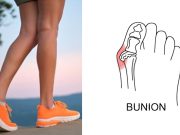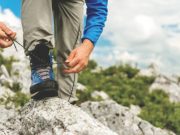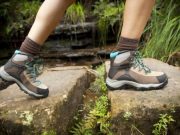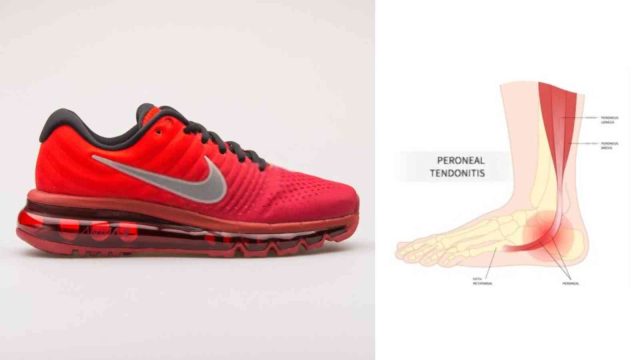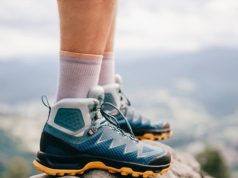Finding the right shoes is essential if you suffer from posterior tibial tendonitis. Not only do they need to be comfortable, but they also need to provide plenty of cushioning and support to help ease your pain. Fortunately, there is now a wide range of walking shoes specifically designed for those with posterior tibial tendonitis. From New Balance 990v5s to Saucony Omni 20s and beyond, these shoes can help you take your first steps towards a healthier lifestyle without compromising style or comfort. In this article, we will explore the best walking shoes for posterior tibial tendonitis so that you can make an informed purchasing decision.
Table of Contents
10 Best Walking Shoes for Posterior Tibial Tendonitis :
01: New Balance 990v5
The New Balance 990v5 is the perfect choice for those suffering from posterior tibial tendonitis. This shoe provides exceptional stability and cushioning, helping to reduce strain on the foot and alleviate some of the pain associated with this condition. The thick sole is designed with a Ndurance rubber outsole to provide superior traction and durability while offering a softer cushioning experience than other walking shoes.
The midsole contains ABZORB foam, which helps absorb shock and dissipate impact, while an Ortholite sockliner enhances breathability and comfort.
The upper consists of a combination of synthetic leather and mesh material that helps create a flexible fit. With all these features combined, the New Balance 990v5 is an excellent choice for those seeking optimal comfort and support when walking with posterior tibial tendonitis.
Pros
- • Made Without Compromise
- • Domestic Value of 70%
- • Suede and Mesh Upper
- • Fifth Iteration of Iconic New Balance 990 Series
- • 10% Student & Emergency Services Discount
- • Innovative Designs Combining Performance & Retro Design Details
- • Grey Made in US 990v5 Grey Running Trainers
Cons
- • Not Available Everywhere
- • Limited Sizing Options
02: Asics GT-2000 10
The ASICS GT-2000 10 is an excellent choice for anyone looking for a stylish and supportive shoe to help with posterior tibial tendonitis. Featuring FlyteFoam Propel Technology in the midsole, the GT-2000 10 provides superior cushioning and energy return for those needing extra underfoot support.
In addition, the rear foot GEL cushioning system also helps reduce shock and disperse impact forces evenly throughout the shoe. The upper of the GT-2000 10 combines synthetic leather and mesh to provide breathability and comfort while providing a snug fit.
The outsole is made from high-abrasion rubber, which not only adds durability but also provides great traction on both indoor and outdoor surfaces. All in all, the ASICS GT-2000 10 is a great choice for those looking for a comfortable yet supportive walking shoe that won’t compromise on style or performance.
Pros
- • Versatile running shoe
- • Quad-density construction
- • Flytefoam midsole layer for cushioning
- • Extra boost of comfort and support
- • Stable for overpronators
- • Ideal for runners on a budget
- • Comfortable and responsive
Cons
- • Pricey
- • Not suitable for all foot types
03: Asics Gel-Kayano 29
The Asics Gel-Kayano 29 is the perfect choice of walking shoes for those who suffer from posterior tibial tendonitis. With a lightweight and breathable mesh upper, these shoes provide superior support and cushioning to help alleviate pain and discomfort.
The heel counter provides additional stability, while the FlyteFoam® Propel midsole cushioning system delivers responsive energy return with each step you take. The DuoMax® Support System adds extra arch support for more secure footing, reducing the risk of slips and falls.
Thanks to its high levels of shock absorption, the Gel-Kayano 29 is ideal for long walks and will help keep your feet comfortable all day.
Pros
- • Stable running experience
- • Responsive feel underfoot
- • Low-profile external heel counter
- • Wide fit design available
- • Breathable mesh upper
- • FlyteFoam™ Propel Technology
- • Guidance Trusstic System® Technology
Cons
- • Expensive price tag
- • Sizing may be inconsistent
04: Brooks Adrenaline GTS 22
The Brooks Adrenaline GTS 22 is a reliable, supportive shoe designed to provide comfort and stability to those suffering from posterior tibial tendonitis. The engineered mesh upper offers a secure fit, while the heel counter provides additional support for the foot. The DNA Loft foam cushioning in the midsole provides soft cushioning and responsiveness for an active stride.
The segmented crash pad provides smooth transitions from heel strike to toe-off. Additionally, the outsole rubber lugs offer excellent grip and traction on any surface, making it an ideal choice for walking or running.
Pros
- • Perfect balance of support and softness
- • Smooth ride and comfort
- • DNA LOFT cushioning underfoot
- • Engineered breathable Air-Mesh upper
- • Ideal for running, treadmill, and everyday use
- • Mid-range running shoe model
Cons
- • Limited availability in sizes and colors
- • May not be suitable for intense workouts due to cushioning
05: Mizuno Wave Inspire 17
The Mizuno Wave Inspire 17 running shoe is designed to cushion and support those suffering from posterior tibial tendonitis. It features a soft midsole construction with U4icX technology that provides superior cushioning and shock absorption, while the midsole Wave Plate offers improved stability and a responsive ride.
The Mizuno Wave Inspire 17 also has a SmoothRide Engineering outsole that creates a smoother transition from heel strike to toe-off. This helps reduce the pressure on the tibial tendon and provides extra cushioning for sore feet. The unique X10 carbon rubber outsole also provides durability and excellent traction in wet conditions.
The Mizuno Wave Inspire 17 is ideal for runners looking for enhanced cushioning and support with every stride.
Pros
- • Soft landing with maximum energy return
- • Double fan WAVE plate for enhanced cushioning
- • AIRmesh upper delivers breathability and comfort
- • X10 rubber sole for durability and traction
- • Wider fit in the women’s version
- • Unrivaled stability and secure fit
Cons
- • Not suitable for long-distance running
- • No arch support
06: Saucony Hurricane 23
The Saucony Hurricane 23 is a great choice for anyone suffering from posterior tibial tendonitis. This shoe offers excellent cushioning and stability to help reduce the pain and stress on the tendon while providing ample support.
The full-length PowerGrid cushioning system provides excellent shock absorption, helping to protect the foot from impact during walking. The hurricane also features a medial post to promote a more natural gait cycle, reducing pronation and providing greater stability.
The combination of these features makes the hurricane an ideal choice for those with posterior tibial tendonitis who are looking for a comfortable walking shoe that will provide adequate support and protection.
Pros
- • Thick Ultra-Plush Cushioning Feels Soft
- • Outsole Swaps Crystal Rubber for a Grippier
- • Fit is Now True to Size
- • Lightweight Cushioning
- • Lively and Fun
- • Responsive and Lively
- • Next-Level Capability and Comfort
- • Designed to Be Bouncy and Well-Cushioned Yet Offer Stability
Cons
- • Expensive Price Tag
- • Limited Choice of Colors
07: Brooks Glycerin GTS 20
The Brooks Glycerin GTS 20 is the perfect choice for anyone looking for a great walking shoe to help manage the symptoms of posterior tibial tendonitis. Featuring innovative technology and superior cushioning, this shoe is designed to provide optimal comfort and support on every step.
Unlike other running shoes, the Glycerin GTS 20 features a full-length DNA Loft midsole that gives you an incredibly soft and responsive ride. The midsole also provides flexible cushioning that adapts to every movement you make while walking, helping reduce the impact on your feet. The midfoot transition zone is also extremely supportive, allowing you to move more naturally and easily.
In addition, the Glycerin GTS 20 has a removable OrthoLite footbed with BioMoGo DNA technology to give you extra arch support and cushioning. This helps prevent painful hotspots in your feet caused by uneven pressure distribution when walking. The seamless upper construction adds extra breathability and comfort while keeping your feet secure during long walks.
If you’re looking for a reliable walking shoe to help manage posterior tibial tendonitis, look no further than the Brooks Glycerin GTS 20! With its superior cushioning, supportive design, and breathable construction, this shoe will keep you comfortable all day!
Pros
- • Super-Soft Cushioning
- • DNA LOFT cushioning provides supreme comfort
- • Softest ever cushioning
- • Features Brooks’s holistic guide rails system
- • Denser foam throughout the entire shoe
- • Make both feet and run happy
- • New stable spin on the classic neutral trainer
Cons
- • Higher cushioned or lighter shoes available
08: Saucony Omni 20
The Saucony Omni 20 is a great option for those with posterior tibial tendonitis. These comfortable and supportive shoes feature Saucony’s signature Everun cushioning in the midsole, which provides a great balance of energy return and shock absorption.
The midsole also has an SRC Landing Zone that helps to reduce impact and provide even more cushioning while walking. The upper is designed with breathable mesh and lightweight synthetic materials to keep feet cool and dry.
The Omni 20 features an external heel counter for extra stability, perfect for those who need extra support due to their condition.
With its comfort and support, the Saucony Omni 20 is an ideal shoe choice for anyone with posterior tibial tendonitis.
Pros
- • Signature Support
- Smoother Ride Than Ever Before
- • More Beveling at the Heel and Forefoot for Flexibility
- • Easy, Seamless Ride
- • Smooth Heel-to-Toe Transitions
- • Stable and Comfortable Ride Every Time
- • Improved Midsole and Outsole Design, Improving Durability and Efficiency
Cons
- • No Reviews Available
- • Potential Issues with Fit or Comfort Not Yet Known
09: Hoka Arahi 6
The Hoka Arahi 6 is great for anyone suffering from posterior tibial tendonitis. These shoes offer superior cushioning and support to keep your feet comfortable throughout the day. The midsole features EVA foam, a combination of RMAT and EVA that provides great responsiveness, and an engineered mesh upper for breathability.
It also has a rockered platform that helps guide the foot through its natural gait cycle, making walking easier. The Hoka Arahi 6 also has an OrthoLite® insole which provides cushioning and breathability to help keep your feet dry and cool during long walks.
Additionally, the durable rubber outsole offered superior grip on slippery surfaces and added durability on city streets. The Hoka Arahi 6 is a great option for anyone looking for reliable comfort while dealing with posterior tibial tendonitis.
Pros
- • Lightweight and Exceptionally Comfortable
- • Lively Support for a Wide Range of Runners
- • Plusher Feel than Previous Models
- • J-Frame Technology Designed
- • Lighter Weight and More Comfortable
- • Ultra-Lightweight Cushioning
- • Moderate Stability Shoes
Cons
- • Less Stability Compared to Other Stability Shoes
10: NIKE ZOOM STRUCTURE 24
The NIKE ZOOM STRUCTURE 24 is designed for athletes with posterior tibial tendonitis, offering superior cushioning and support. The full-length Zoom Air unit provides a responsive feel to help reduce fatigue and make every stride comfortable. A dynamic support system helps stabilize the foot during side-to-side movement, reducing stress on the lower legs.
The outsole pattern helps grip surfaces from any angle, making this shoe ideal for uneven terrain. The breathable mesh upper keeps your feet cool, while Flywire cables provide a secure fit. Whether walking for pleasure or running for sport, the NIKE ZOOM STRUCTURE 24 offers optimal comfort and stability.
Read more: Best walking shoes for overweight women
Pros
- • Zoom Air unit in forefoot offers responsive cushioning
- • Creates energy return to help drive you, forwards
- • Great mid-sole arch support
- • Very durable
- • True to size
- • Holds up well to daily use
- • Lightweight design
- • Neutral arch support
- • Secure fit
Cons
- • Pricey compared to other shoes
- • Not suitable for more extreme running activities.
People also ask:
What is posterior tibial tendonitis?
Posterior tibial tendonitis is a condition that results when the tendon that connects the calf muscle to the shinbone becomes inflamed. This can cause pain and difficulty walking. The best way to treat posterior tibial tendonitis is with rest, ice, and ibuprofen.
What are the most common causes of posterior tibial tendonitis?
The most common causes of posterior tibial tendonitis are overuse, poor biomechanics, and structural abnormalities. Overuse can be due to a sedentary lifestyle, excessive running or jumping, or using the wrong type of equipment.
What are the symptoms of posterior tibial tendonitis?
The most common symptom of posterior tibial tendonitis is pain and tenderness in the calf. Other symptoms may include swelling, redness, and warmth. If you are experiencing any of these symptoms, seeing a doctor as soon as possible is important.
What are the treatments for posterior tibial tendonitis?
There is no one-size-fits-all answer to this question, as the best treatment for posterior tibial tendonitis will vary depending on the severity of the condition and the individual’s symptoms. However, some common treatments include rest, ice packs, compression garments, and physical therapy.
What are some tips for walking in shoes that protect my posterior tibial tendon?
When choosing walking shoes, it is important to consider the terrain you will be walking on. If you are primarily walking on pavement or other hard surfaces, a shoe designed for those surfaces will work just fine. However, if you plan on hiking or traversing through soft or wet terrain, you will want to choose a shoe specifically designed for those activities. Additionally, select shoes that fit well and are comfortable so you can walk long distances without feeling pain or discomfort.
Is it necessary to see a doctor before starting a treatment plan for posterior tibial tendonitis?
No, seeing a doctor before starting a treatment plan for posterior tibial tendonitis is unnecessary. However, if you have any other medical conditions or are taking any medications, it is always advisable to speak with your doctor first. Additionally, follow the prescribed treatment plan carefully to ensure the best results.
Are there any long-term effects of posterior tibial tendonitis?
Unfortunately, posterior tibial tendonitis has long-term effects, as the injury can cause chronic pain and inflammation. In addition, it can lead to a reduced range of motion and decreased mobility. If left untreated, posterior tibial tendonitis may even result in surgery.
Conclusion
In conclusion, when it comes to finding the best walking shoes for posterior tibial tendonitis, a wide variety of options are available. New Balance 990v5, Asics GT-2000 10, Asics Gel-Kayano 29, Brooks Adrenaline GTS 22, Mizuno Wave Inspire 17, Saucony Hurricane 23, Brooks Glycerin GTS 19, Saucony Omni 20, Hoka Arahi 6 and NIKE ZOOM STRUCTURE 24 all offer their unique advantages in terms of comfort and support for those with this condition. Therefore, it is important to consider each option carefully before making the right decision for you.





